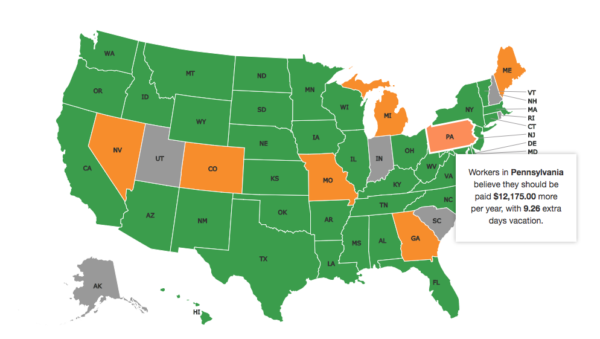By Betsy Natter
A recent survey by Intelligent Video Solutions stated that Pennsylvania workers felt that they deserved to paid an additional $12,175 annually. And while the survey was not extensive, covering only 3,000 workers nationwide, it does raise some questions. What is a fair salary for a particular field of work? Am I getting paid what I’m worth? As an employer, what should I be paying my workers?
Searching for a job and hiring new employees is always an involved task on both sides of the coin. Individuals seeking employment want to earn the highest amount possible and employers hope to acquire talented and skilled workers without breaking their budgets. Job-seekers often balk at the desired salary question on applications and employers want to be able to pick and choose from among their candidates those qualified workers who won’t cost them too much, both in wages and lost time in interviewing someone who clearly has unrealistic salary expectations.
So, how do you determine an appropriate wage or salary for any given occupation or position? Several tools may serve as guidelines for both parties, whether you are starting a new career, seeking a raise, or expanding your employee base.
For the job hunter, several online resources are easily available giving an industry wide average of reported salaries, by occupation and in some cases by company. A great place to start is the Pennsylvania Center for Workforce Information & Analysis which offers a breakdown of occupations and average hourly and annual salaries for hundreds of occupations. Reports are available by metropolitan areas as well as by county. For example, according to the Occupational Wage Report for Bucks County released in May 2016, administrative assistants or secretaries made on average an hourly rate of $18.23 or annually $37,920. Nationally, based on figures reported by the U.S. Bureau of Labor Statistics, the average was a slightly lower $17.38 per hour or $36,140 annually for the same time period.
However, when comparing local salaries with national averages, it is important to evaluate hourly rates and salaries in light of cost of living expenses within a region. For example, if you live in Bucks County, part of the greater Philadelphia metropolitan center, your cost of living may be very different than in another area of the country. Salaries are adjusted based on how much it costs to live and do business in any given area. This means that someone doing the exact same job as you may make more or less money depending on where they live in the country.
A second resource for gaging wage levels are job search engines sites such as indeed.com and glassdoor.com. While these site offer job listings, they also report on salaries offered by local companies for a variety of positions. Current or previous employees of company “X” report their position, salary or hourly rate and sometimes job satisfaction experience as an employee of their company. This information can give prospective employees a heads up on what to expect when applying for a position. Keep in mind, however, that this information is reported by site users and is collected for the past 12 months. Actual salaries within a company or region may differ.
For the employer, business sites such as salary.com offer help with determining appropriate compensation packages including benefits. The service, known as benchmarking, helps employers to identify the market rate for an open position within their company by comparing it to a similar position industry wide.
Finally, expect that salary or hourly rates will also vary based on qualifications and the amount of experience a perspective employee can offer. If a compensation range is offered, candidates with fewer credentials should expect an offer on the lower end of the spectrum and work towards increases as their experience and skills grow.
We Are Supported By:










